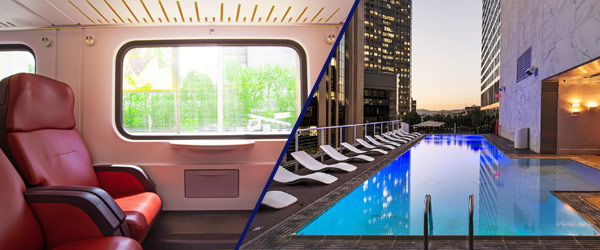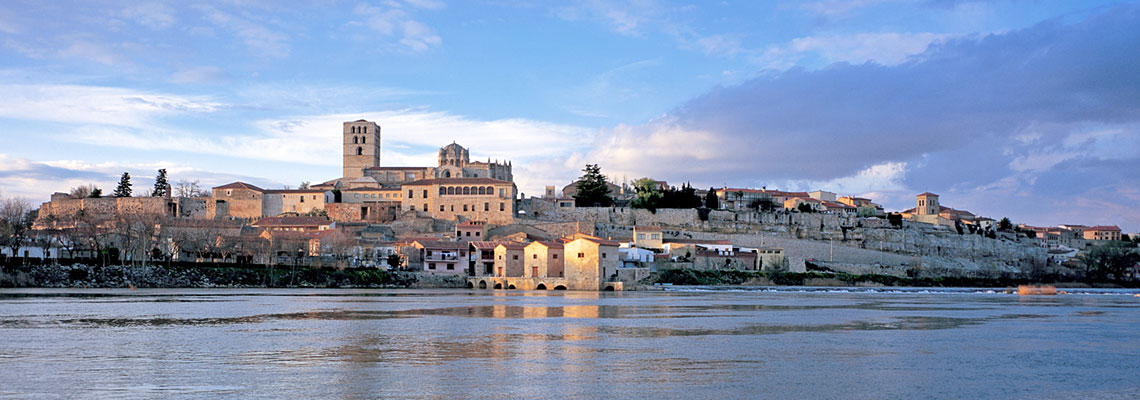
Zamora
Zamora
THE CITY
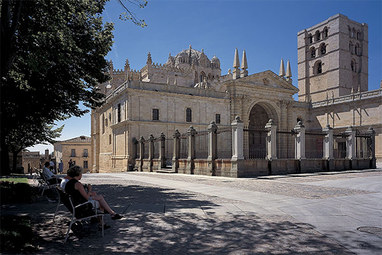
An inland city, small and well-groomed, lovely, intimate and, yes, unknown: Zamora pleasantly surprises. Embracing a river—the omnipresent Duero, the protagonist of verses resonating in the murmur of the waters which tickle the ears of those who approach its banks—it is a city for all ages which encourages visitors to live it and enjoy its tranquil beauty and the echoes of its medieval splendour.
City of the Romancero, “the well-walled”, and city of the Romanesque… its historic old town and the medieval suburbs include, besides the magnificent Cathedral and the Castle, the largest urban concentration of Romanesque constructions in the entire Iberian Peninsula: over twenty churches, the stone bridge, the curtain walls and several palaces and houses.
Zamora’s Holy Week is just as famous: it was declared of International Tourist Interest in 1986. The earliest known records establish its origins in the 13th Century and today it continues to harbour the incipient essence in its processions: austerity, prayer and silence. It clearly represents one of the most important festivals of the city.
In today’s Zamora, the vestiges of its medieval splendour intermingle with the elegant modernist architecture of some buildings and with interesting examples of contemporary architecture, offering visitors, among the lively reality of its stones, a reliable testimony of the passage of time and the progression of fashions and customs.
Seductively, Zamora entices one to wander placidly through its streets, to ponder its river or get close enough to hear its susurration, to look and marvel at the history and legends of the city of Spanish Romance, to enter in numerous temples and appraise its ancient stones which allow your spirit to fly… and, of course, to yield to temptation and seek the pleasures of the palate in the suggestive delicacies of local aromas and flavours.
ESSENTIALS
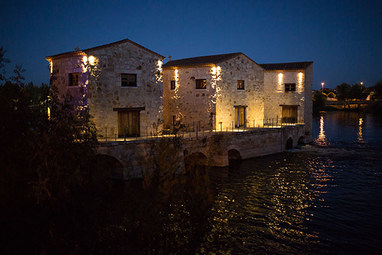
Rising up next to the first wall, adjacent to the restored Castle ruins, the Cathedral of Zamora is an excellent illustration of Romanesque art whose most emblematic feature is its singular dome covered with stone scales.It represents one of the so-called “Domes of the Duero”: curious “umbrella” domes which for some denote a Byzantine influence, while others attribute them to the French or Lombard schools.
Nearby, we find the Castle of the city and its gardens hemmed in by the battlements: a privileged overlook of the Duero and an open-air gallery for the works of the local artist Baltasar Lobo. He was one of the most important European sculptors of the 20th century and his Museum is now located in the Casa de los Gigantes, next to the entry gate of the gardens.
A visit to the quaint Cathedral Museum will expose you to a magnificent and impressive collection of Flemish tapestries from the 15th – 17th centuries which were donated to Zamora by the Count of Alba y Aliste in 1608. A stone’s throw away, we find historically significant landmarks like Traitor’s Gate (also known as Loyalty Gate, depending on one’s point of view) or the palace of Arias Gonzalo, known as the house of El Cid, next to Bishop’s Gate; as well as a contemporary avant garde construction in the seat of the Consejo Consultivo de Castilla y León: a work of the architect Alberto Campo Baeza from Valladolid.
After the unavoidable visit to the Cathedral and its surroundings, a well-deserved break must be taken to have a snack of some sort. We can taste the rich pastries of Zamora accompanied by hot chocolate or tea in any one of the bakeries scattered throughout the old town, or enjoy the ample offering of tapas and pinchos in the establishments in and around the Main Square.
GET MOVING
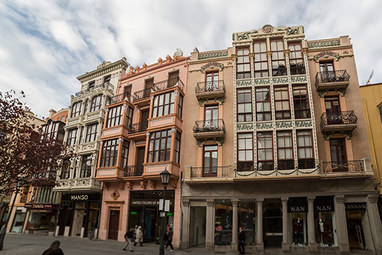
The Train Station in Zamora, where the AVE arrives, is a monument in and of itself and is located near the Bus Station. Through the former, Zamora is connected to Madrid and Galicia, as far as long distances are concerned, and to Puebla de Sanabria and Valladolid less than an hour away.The latter provides service to the rest of the capitals of the Castile region as well as to the province which is full of small villages and surprising natural spaces like Sanabria Lake, the Culebra mountain range and the natural park of the Arribes del Duero or the Lagunas de Villafáfila: a nature centre for migratory birds.
Within the city limits, the usual public transport options are available: taxis and city buses. Near the river there is a bike path known as the Anillo Verde, or Green Ring, which runs along the riverbanks of the Duero from Valorio Park to the area called la Aldehuela.
Additionally, the sightseeing train from spring through autumn starts in the Main Square and offers a relaxing tour of the city including a quick trip across the river for the best views of the Cathedral and Zamora’s skyline.
However, Zamora, above all, is a city which invites visitors to get around on foot. Its numerous pedestrian and semi-pedestrian streets allow people to stroll around pleasantly, put their finger on the pulse of its daily life and unhurriedly savour its calm tranquillity while they admire its lovely monuments, stores, bars and plazas.
ALTERNATIVE
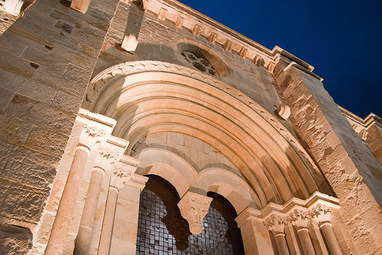
Zamora and the Duero are inseparable. Once a source of wealth for the city, today it represents one of the principle green spaces of the city and a privileged recreational area for the city’s inhabitants.Paseo por el Duero is an original route by the river skirting the city limits where history, culture, landscape and nature go hand in hand. This unique and surprising guided visit replete with anecdotes and curiosities, enigmas and legends offers a new and alternative look at Zamora down by the waterfront. The visit not only includes some of the most remarkable and unknown examples of the city’s Romanesque, including the churches Santa María de la Horta, San Claudio de Olivares and Santo Tomé, but also allows one to admire the exceptional treasure in its river’s spectacular biodiversity, to contemplate the awesome panoramic views of its old town and to discover the attractive and remote world of its water mills, dams, bridges, old factories and artisan traditions.
On the other hand, we can also explore another facet of Zamora which goes beyond the typical Romanesque, the Duero or Holy Week; and even surpasses the modernist city, the rich cuisine and good wines.
A facet that transcends the past, yet far from ignoring it, transposes it to a new age: the urban art, young and fresh, which rejuvenates Zamora can be found on walls and improvised canvases of abandoned buildings. Thus, Claudio Rodríguez, the poet whose literary route meanders through the town, awaits on one of the walls bordering the Troncoso scenic overlook, eternally pondering the Duero alongside visitors. Feel the magic of a stretch of ramparts which no longer exists but once did at the Pizarro overlook, or the ingenious composition of rural contraptions which decorate the backside of the Town Hall. A compilation of all can be found in Graffitiza, a downloadable application which locates them on a city map. There are more than twenty-five.
TO SAVOUR
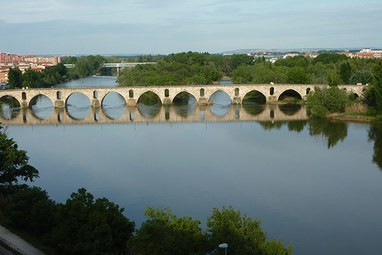
Zamora’s cuisine is based on local products which emblazon numerous seals of approval ratifying their superior quality. The cheese of Zamora, the chickpeas from Fuentesaúco, the lentils from Tierra de Campos and the large white beans from Sanabria, the wild mushrooms, the beef from Aliste and Sayago, the suckling pig, the sausage and cured meats are the delectable fruits of labour in a province which specializes eminently in the agrarian sector.
Among the most well-known and characteristic dishes of the region, in addition to the traditional garlic soup, rice a la zamorana (with pig’s ears, snout and feet) and codfish a la tranca are perhaps the most popular. To enjoy them accompanied by a tasty wine from one of three officially recognized Appellations of the province (Toro, Arribes and Tierra del Vino) or from the Valles de Benavente is a luxury available to all visitors. The aromas of Zamora’s bakeries entice passers-by, entreating them to pause and take notice of the traditional sweets: aceitadas (biscuits), rebojos (cakes), amarguillos (almond pastries), cañas zamoranas (cream filled cannoli)…
Tapeo, or the Spanish version of bar hopping, is a daily activity in Zamora. The bars of virtually every establishment throughout the city are covered with delicious tapas and snacks, although two areas are most frequented: los Lobos, between the centric Santa Clara and San Torcuato streets, and the Main Square with its adjacent Herreros street. Additionally, the entire city becomes an incomparable showcase of local cuisine from April through May when bars compete to make the best tapas in the De tapas por Zamora contest (http://www.detapasxzamora.com) or with the lamb-based competition Jornadas del Lechazo http://www.ilovelechazo.com
DO YOUT LEAVE BEFORE YOU ...

Balborraz street is one of the most antique streets of Zamora. Today, it continues to be one of its most photographed as it descends steeply from the Main Square towards the Duero between colourful and singular buildings.Its name derives from the gate which was demolished in the 16th century called “la Cabeza” which means “bab al ras” in Arabic. Witnessing some of the most important processions of Holy Week from here, or simply taking a walk down its irregular flagstones, transports visitors back to the city’s Arcadian age of artisans. The bottom of the street leaves us a stone’s throw from the Stone Bridge, recently pedestrianized, which takes us to the other side of river where we can admire how the old town traces its characteristic profile upon the horizon with the Cathedral and the imposing wall at the forefront.
Near the bridge, and back on the bank which sleeps beneath the walls, halfway up the Pizarro slope, we find the Medieval Cities Interpretation Centre: a glass building which rises above an opening in the wall and an original work of the architect Rafael Berchez. In addition to learning about the genesis of medieval Zamora and contemplating a mock-up which recreates the appearance of Balborraz in that era, visitors will never forget the picture perfect image of the river from the Zen overlook inside the building.








